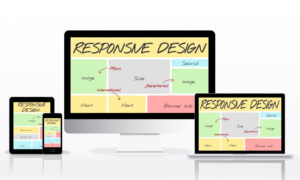Typography is a powerful tool that can significantly impact how your website communicates with its audience. From selecting the right typeface to maintaining readability and responsiveness, a well-designed typographical experience can set your website apart from the competition and drive higher search engine rankings. In this comprehensive guide, we’ll explore ten crucial tips for effective web design typography that will elevate your website’s aesthetics and make it more appealing to visitors.
Table of Contents
Choose the Perfect Typeface
Selecting the right typeface for your website is the first step in creating a captivating typography design. Consider your brand’s personality and message, and choose a clean, versatile font family that complements your overall design. Ensure that the selected typeface works seamlessly across various devices and screen sizes, providing a consistent user experience.
Master the Art of Hierarchy
An effective typographical hierarchy is vital for guiding your readers through your content. Utilize varying font sizes, weights, and styles to establish a visual hierarchy, emphasizing critical elements and maintaining a harmonious overall appearance. A well-structured hierarchy helps users understand your content’s flow and find essential information quickly.
Mind the Line Spacing and Line Length
Proper line spacing and line length are essential for optimal readability. Avoid cramped text by providing ample line spacing, ensuring that your content is easy on the eyes. An ideal line length prevents readers from losing their place while scrolling, creating a pleasant reading experience.
Embrace Responsive Typography
With the growing number of mobile users, responsive typography is now a necessity. Implement responsive design principles to ensure that your typography adapts gracefully to different screen sizes, resolutions, and orientations. A mobile-friendly website enhances user engagement and positively impacts search engine rankings.
Use Contrast for Emphasis
Contrast is a powerful tool that can draw attention to specific elements of your content. Create a significant contrast between headings and body text to highlight crucial information and help users quickly grasp your main points. A well-executed contrast enhances both aesthetics and readability.
Prioritize Readability
While it might be tempting to use fancy and creative fonts, readability should be your top priority. Choose fonts that are easy to read and maintain consistent readability throughout your website. A readable typography design ensures that users can consume your content effortlessly.
Limit the Number of Fonts
Too many fonts can make your website look cluttered and unprofessional. Stick to a maximum of three fonts: one for headings, one for subheadings, and one for body text. Maintaining font consistency creates a polished and cohesive visual identity.
The Power of Whitespace
Whitespace, also known as negative space, is a crucial element in typography design. Embrace whitespace to give your content room to breathe and provide a clean and uncluttered layout. Well-utilized whitespace enhances content comprehension and visual appeal.
Test for Accessibility
Web accessibility is essential for an inclusive user experience. Ensure that your chosen fonts and color combinations meet accessibility standards, making your content easily readable for individuals with visual impairments. Prioritizing accessibility also demonstrates a commitment to inclusivity.
Continuously Improve and Optimize
Effective typography is an ongoing process. Regularly review your website’s typography, gather user feedback, and analyze analytics to identify areas for improvement. Implement A/B testing to understand what resonates best with your audience and optimize your typography accordingly.
FAQs:
Q1: Why is typography crucial for web design?
Typography plays a vital role in how your website communicates with visitors. It sets the tone, enhances readability, and improves overall user experience, impacting how your audience perceives your content and brand.
Q2: Can typography influence search engine rankings?
Yes, it can. An engaging typography design that keeps visitors on your site and encourages them to explore further signals search engines that your content is relevant and valuable, positively impacting your rankings.
Q3: How can I choose the perfect typeface?
Consider your brand’s personality and the emotions you want to evoke. Look for a clean, versatile font family that complements your brand while maintaining readability across devices.
Q4: What is typographical hierarchy?
Typographical hierarchy is the arrangement of text elements in a visually structured manner. It uses font size, weight, and style to guide readers through content, emphasizing the most important information.
Q5: Why is readability important in web design?
Readability directly affects how users engage with your content. Easy-to-read typography ensures that users can quickly consume information, leading to better user experience and longer on-page time.
Q6: Can I use decorative fonts in my design?
While decorative fonts can add flair, they should be used sparingly. Balance creative choices with readability to maintain a professional and user-friendly design.
Q7: Is responsive typography necessary for my website?
Yes, it is crucial. With the majority of users browsing on mobile devices, responsive typography ensures that your content looks great and remains legible on all screen sizes.
Q8: How can I optimize my typography for accessibility?
Choose fonts with good legibility and high contrast. Ensure that font sizes are adjustable, and colors meet accessibility standards. Test your design with assistive technology to ensure inclusivity.
Q9: Should I stick to a limited number of fonts?
Yes, limiting the number of fonts creates a cohesive design. Stick to a maximum of three fonts to maintain consistency and professionalism.
Q10: How can I continually improve my typography design?
Regularly gather feedback from users and conduct A/B testing to identify what works best for your audience. Continuously analyze analytics and make necessary adjustments for optimal results.
Effective web design typography is a powerful tool for enhancing user experience, engaging visitors, and improving search engine rankings. By following the ten tips outlined in this guide, you can create a visually appealing and user-friendly website that stands out from the competition. Prioritize readability, embrace responsiveness, and continuously optimize your typography to ensure that your website delivers an impactful message to your audience.




